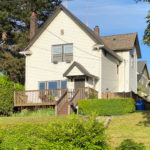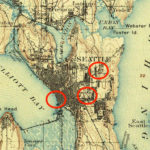All Over The Map: The story of William Grose, one of Seattle’s earliest black entrepreneurs
Jun 19, 2020, 11:23 AM | Updated: 11:23 am
William Grose is a 19th century wealthy Seattleite and community leader who isn’t as well-known as he should be in his adopted hometown. But that might be changing.
William Grose Park is located at East Howell Street and 30th Avenue East. The half-acre park is several blocks south of Madison Street, and a few blocks east of Martin Luther King Jr. Way. There are mature cedar trees and a Seattle “rainbow sign” announcing the name on the west side of the park; a winding paved path leads through a hilly meadow and past a few picnic tables over to the next block east.
The land was purchased by the City of Seattle in 1970 and was known as the generic “30th Avenue Mini Park” until 1983. An effort by the Black Heritage Society of Washington and a group called Madison Valley Concerned Citizens resulted in the park being renamed for Grose, and a plaque was dedicated there in his honor on September 24, 1983.
William Grose’s relative anonymity in a city where early history is dominated by people with names like Denny and Yesler is probably because he was one of the first black people to call Seattle home. Grose, whose name was sometimes spelled “Gross,” was born in 1835 in Washington, D.C., and seems to have been something of a larger-than-life character.
In addition to measuring 6-feet-2-inches in height, Grose is said to have weighed more than 400 pounds. At age 15, he joined the U.S. Navy and traveled extensively around the world, and was later in California during the later years of the Gold Rush there.
From California, Grose traveled to Panama to help free enslaved people, and headed to Canada during the Fraser Valley Gold Rush in the late 1850s. After working aboard a boat on Puget Sound and encountering Washington Territorial Governor Isaac Stevens, Grose settled in Seattle sometime around 1860.
When he first arrived in Seattle, Grose worked as a cook, but eventually opened up a restaurant of his own called “Our House” on the south side of Mill Street — now Yesler Way — at Commercial Street, or what’s First Avenue. A few years later, he built a three-story hotel, also called “Our House,” on Yesler’s Wharf a block or so away.
Grose famously fed future shipyard owner and future mayor Robert Moran for free when Moran first arrived in town, penniless and hungry; it’s likely Grose fed countless others this way who remained less well-known.
Business was good at the hotel and restaurant, and Grose became a wealthy man. One estimate from 1891 says that he had assets of more than a quarter-million dollars, and a newspaper account from around the same time describes him as one of the city’s most “extensive taxpayers.”
A decade before that, Grose purchased 12 acres of land in the Madison Valley from Henry Yesler and built a house (not too far from the future park) on 24th Avenue that still stands. Historians consider that property purchase as the nucleus of the black community which grew in that area beginning in the 19th century.
At least one source, a 1944 book written by Calvin Schmid and published by the University of Washington called “Social Trends in Seattle,” describes the arrival of William Grose as a watershed for what could be considered a kind of 19th century “white flight.”
Schmid writes, “The settlement of Negroes in the Madison hill district was in a real sense an historical accident related almost wholly to a unique character, William Gross … With the removal of Mr. Gross and his family to the hill [in the Madison neighborhood], the invasion of Negroes began. There was much opposition to the migration on the part of the white residents of the Madison area. Finally they decided to sell, but not to rent, to the newcomers.”
William Grose died in his 24th Avenue house in July 1898 of what was described as “dropsy,” which is the old term for edema or swelling (that was likely caused by some other underlying condition). He’s buried not far away at Lake View Cemetery.
William Grose Park is just one of the many places highlighted in a jewel of a book from 1997 called “Tribute: Seattle Public Places Named for Black People.” It was written by Mary Henry, one of the founders of the Black Heritage Society of Washington, and is available from many online booksellers.
With a major recent development, William Grose may yet become better known in the city where he was once one of its wealthiest residents.
Earlier this week, it was announced that the City of Seattle will transfer old Fire Station Six at 23rd and Yesler to nonprofit Africatown Community Land Trust. In the historic Art Deco structure, the group plans to create the William Grose Center for Enterprise and Cultural Innovation, which has been described as “a long-planned incubator for Black-owned businesses.”
You can hear Feliks every Wednesday and Friday morning on Seattle’s Morning News and read more from him here. If you have a story idea, please email Feliks here.



















